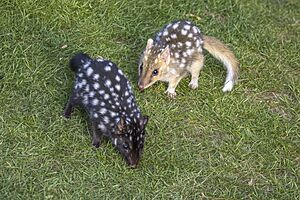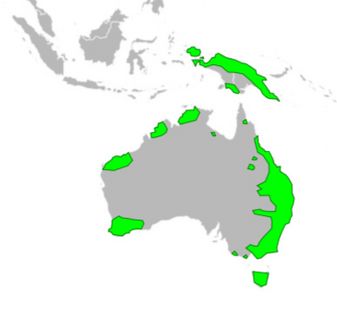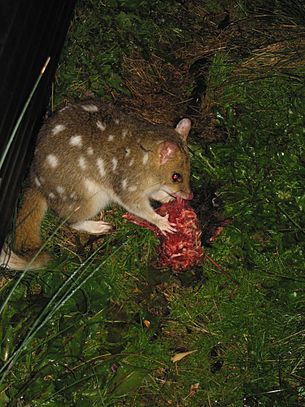Quoll facts for kids
Quick facts for kids Quoll |
|
|---|---|
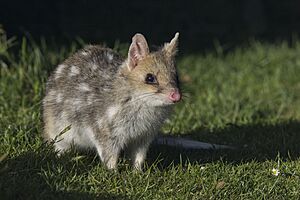 |
|
| Eastern quoll (Dasyurus viverrinus) | |
| Scientific classification |
|
| Kingdom: | Animalia |
| Phylum: | Chordata |
| Class: | Mammalia |
| Infraclass: | Marsupialia |
| Order: | Dasyuromorphia |
| Family: | Dasyuridae |
| Subfamily: | Dasyurinae |
| Tribe: | Dasyurini |
| Genus: | Dasyurus É. Geoffroy, 1796 |
| Type species | |
| Didelphis maculata Anon., 1791
(=Dasyurus viverrinus Shaw, 1800) |
|
| Species | |
Quolls are amazing marsupials that eat meat. They live in Australia and New Guinea. These animals are mostly active at night, sleeping in a den during the day.
There are six different types of quolls alive today. Four of these species live in Australia, and two live in New Guinea. Scientists have also found fossils of two other quoll species. These fossils show that quolls have been around for a very long time!
Quolls come in different sizes, from about 300 grams (like a small can of soda) to 7 kilograms (like a small dog). They have brown or black fur with white spots, and cute pink noses. Quolls usually live alone, except when they come together to mate in winter. A mother quoll can have many babies, but only a few can survive. Quolls typically live for 1 to 5 years.
Quolls eat small animals like mammals, birds, lizards, and insects. Sadly, the number of quolls has dropped a lot since Europeans arrived in Australia. One type, the eastern quoll, even disappeared from mainland Australia in the 1960s.
Big dangers for quolls include poisonous cane toads, wild cats and foxes, and cities growing bigger. People are working hard to help quolls. They are breeding them in zoos and releasing them back into the wild.
Contents
What Are Quolls?
The name Dasyurus comes from an old Greek word meaning "hairy-tail." This name was given to quolls in 1796.
Long ago, in 1770, Captain Cook saw quolls when he explored Australia. He used a local Aboriginal name for them. Early European settlers called quolls "native foxes" or "native cats." But these names were confusing because quolls are marsupials, not foxes or cats.
In the 1960s, a famous animal expert named David Fleay suggested we use the name "quoll" again. This helped people understand what these unique animals really are.
Scientists have found quoll fossils in caves in Queensland, Australia. These fossils show that different types of quolls lived there a long time ago. The oldest quoll fossil found so far is from a species called D. dunmalli. It was found in Queensland and is related to the spotted-tailed quoll.
Quolls belong to a group of animals called Dasyurini. This group also includes the Tasmanian devil, antechinus, kowari, and mulgara. Scientists believe quolls started to evolve about 15 million years ago. All the different types of quolls we see today had developed by about four million years ago.
Types of Quolls
There are six living species of quolls:
| Image | Name | What they are like | Where they live |
|---|---|---|---|
 |
tiger quoll or spotted-tail quoll (Dasyurus maculatus) | These quolls like to live in rocky dens. They are often found where there is a lot of prey. Their numbers have gone down a lot in Queensland. | South-eastern Australia, especially in places like the Blackall/Conondale ranges. |
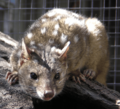 |
western quoll or chuditch (Dasyurus geoffroii) | Western quolls used to live in most of Australia. Now, they are much rarer because of cane toads, predators, and losing their homes. | Only in the Jarrah Forest and parts of the Wheatbelt in Western Australia. |
 |
eastern quoll (Dasyurus viverrinus) | These quolls used to be common across south-eastern Australia. But they disappeared from the mainland in the 1960s. | Now mostly found in Tasmania. They have been brought back to a few places on mainland Australia. |
 |
northern quoll (Dasyurus hallucatus) | A century ago, they lived in the northern part of Australia. Today, they prefer rocky areas with lots of rain. Some have been moved to islands to protect them from cane toads. | Common on small islands around northern Australia. |
| bronze quoll (D. spartacus) | This quoll is special because it's the only mammal found in its area of New Guinea but not in northern Australia. Long ago, Australia and New Guinea were connected by land. | Found in the southern part of New Guinea, south of the Fly River. | |
 |
New Guinean quoll (Dasyurus albopunctatus) | They usually live high up in the mountains, around 1000 meters high. They are not found in the lowlands. | Found throughout most of New Guinea. |
This family tree shows how quolls are related to other animals:
| Dasyuromorphia |
|
||||||||||||||||||||||||
What Quolls Look Like
Quolls are shy animals that are active at night. Adult quolls can be from 25 to 75 cm long. Their furry tails are about 20 to 35 cm long.
Their weight changes a lot depending on the type of quoll. Male western and eastern quolls weigh about 1.3 kg. Females weigh around 0.9 kg. The spotted-tailed quoll is the biggest. Males can weigh about 7 kg, and females about 4 kg. The northern quoll is the smallest. Males weigh 400 to 900 grams, and females 300 to 500 grams.
Quolls have sandy, brown, or black fur. They have white spots all over their bodies. They also have bright pink noses and long snouts.
Female quolls have a pouch during breeding season. This pouch opens towards their tail. The spotted-tailed quoll is different, it has a pouch that opens forward. Quolls usually live for 1 to 5 years. Bigger quolls tend to live longer.
Where Quolls Live
Quolls are native to mainland Australia, Tasmania, and New Guinea. The six species used to live in many places. Now, they are only found in certain areas.
Even though quolls mostly live on the ground, they can also climb trees. Each type of quoll lives in different places. The spotted-tailed quoll likes wet areas. The western quoll also likes wet places, but it can live in dry parts of Australia too. The northern quoll lives in tropical areas with lots of rain.
How Quolls Behave
Quolls are meat-eating marsupials. They are mostly active at night. They sleep in hollow logs or rocky dens during the day. At night, they come out to hunt for food. Sometimes, you might see a quoll looking for food during the day.
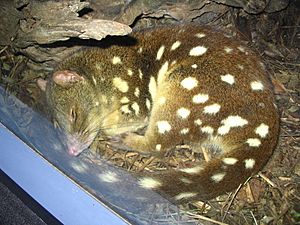
Quolls usually stay on the ground, but they are good at climbing trees. They mark their territory many kilometers away from their dens. A male quoll's territory often overlaps with many female territories. Males and females only meet to mate.
Some quolls use shared toilet areas, often on a rock. These spots can have many droppings. Quolls usually live alone. They only spend time with other quolls when they are mating or doing other social things.
What Quolls Eat
Quolls are mostly meat-eaters. Smaller quolls mainly eat insects, birds, frogs, lizards, and fruit. Larger quolls eat birds, reptiles, and bigger mammals like echidnas and possums.
The spotted-tailed quoll mostly eats mammals like brushtail possums, rabbits, and small animals without backbones. What they eat can change depending on what food is available. After bushfires, they might eat dead animals or bandicoots if food is scarce. Other quoll species also eat dead animals.
Quolls hunt by sneaking up on their prey. They pin small prey down with their front paws while they eat it. For bigger prey, they jump on it, digging in their claws and biting its neck. Their paws and whiskers help them reach into small holes to find food. Quolls can get all the water they need from their food. This helps them survive during dry times.
Baby Quolls and Reproduction
Quolls mate during the winter months. A baby quoll, called a pup, is tiny when it's born, about the size of a grain of rice. A mother can give birth to up to 30 pups in one litter. However, she can only raise as many as she has teats (usually 6 or 7).
The surviving pups attach to the mother's teats. They drink milk in her pouch for 6 to 8 weeks. After this, the pups leave the teats. The mother can then leave them in a den for over a month.
Quolls become adults when they are one year old. They live for 1 to 5 years, depending on the species.
Dangers to Quolls
Cane toads were brought to Queensland in 1935. Their numbers have grown very quickly. These poisonous toads are a big danger to the northern quoll. Quolls can die if they eat a cane toad. The government says that cane toads are a major threat to northern quolls.
Predators like red foxes and feral cats hunt quolls. They also compete with quolls for food. For example, both quolls and foxes eat rabbits. Since foxes were introduced, quoll numbers have dropped a lot. Foxes have been removed from many islands near Australia to help protect quolls.
Quoll homes are being destroyed by cities growing, new houses, mining, and farms. Large plant-eating animals also damage their homes by trampling grass. Bushfires and weeds also hurt their habitats.
A natural poison called fluoroacetate (Compound 1080) is used in Australia. It helps control pests like rabbits, foxes, and wild dogs. This poison is very toxic to these pests. It is less harmful to native Australian animals because it is found naturally in some plants. However, young quolls might be harmed by the poison.
Helping Quolls Survive
Since 1770, all Australian quoll species have declined. This is because their homes are being destroyed by human development. European rabbits were brought to Australia in 1788. Quolls used to hunt rabbits. Before 1870, many people said quolls stopped rabbits from spreading on the mainland. But rabbits thrived on islands. To protect their chickens, early settlers killed quolls. After that, rabbit numbers grew out of control.
Scientists study quolls in zoos to help save them. They learn about their health and what they eat. This helps them plan to move quolls to new areas in the wild.
Some people think allowing quolls as pets could help save them. But more research is needed to see if this would truly help them in the long run.
Spotted-tailed Quoll Conservation
In 2011, five spotted-tailed quoll pups were born at Wild Life Sydney. The parents were young, only one year old. This was done because older male quolls can sometimes be aggressive towards females. Four of the pups went to other zoos. One pup, named Nelson, stayed to help teach people about quolls.
In 2023, a farmer in South Australia caught a spotted-tailed quoll. He thought it was a fox or cat eating his chickens. This was the first time a quoll was found in South Australia in 130 years! It was thought to be extinct there. The quoll was given to the wildlife service for care and DNA testing.
Western Quoll Conservation
Programs that control foxes have helped the western quoll. The Department of Environment and Conservation in Western Australia watches western quoll populations. They also study how fox control, logging, and planned fires affect them.
The Perth Zoo has a successful breeding program for western quolls since 1989. They have bred over 60 western quolls. Most of these have been moved to a conservation park. There are also plans to move them to other reserves.
Eastern Quoll Conservation
In 2003, eastern quolls were brought back to a special fox-proof sanctuary in Victoria. In 2016, they were also successfully reintroduced to a sanctuary in the Australian Capital Territory.
Bristol Zoo in the UK was the first zoo there to successfully breed eastern quolls.
In 2018, twenty eastern quolls from Tasmania were released into Booderee National Park in New South Wales. However, in 2021, it was reported that this reintroduction was not successful.
Northern Quoll Conservation
Northern quolls are in danger from poisonous cane toads. But a project from the University of Sydney in 2010 is teaching them to avoid eating these toads.
In 2008, the Northern Territory Wildlife Park had their first litter of northern quoll pups. Quolls bred well there, with over 15 litters in that year alone.
Bronze Quoll Conservation
The bronze quoll lives in a few protected areas, like Wasur National Park. More research is needed to understand where they live and what dangers they face. This will help with future conservation efforts.
Culture Contexts
The Northern Arrernte language group of Aboriginal people call the quoll "Tjilpa."
See also
 In Spanish: Quoles para niños
In Spanish: Quoles para niños


